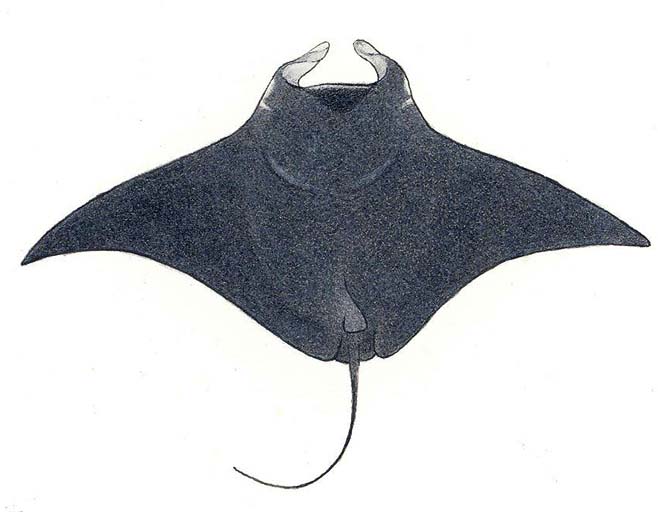|
Manta birostris (Manta)
(Walbaum, 1792)
Life
> Eukaryotes >
Opisthokonta
> Metazoa (animals) >
Bilateria >
Deuterostomia > Chordata >
Craniata > Vertebrata (vertebrates) > Gnathostomata (jawed
vertebrates) > Chondrichthyes > Elasmobranchii > Batoidei >
Myliobatoidei >
Mobulidae
 |
|
Manta birostris (Manta) [Illustration
by Ann Hecht ©] |
Identification
A giant ray with paired long head fins on an
extremely broad head, mouth at front of head, and upper surface of
disk covered with denticles. Colour blackish above, sometimes with
white shoulder patches, white below with grey edging on disk.
Size
One of the largest living fishes, to at least 6.7 m DW.
Range
Southwest and east coast, Cape Point to Natal and probably
northwards; circumtropical.
Habitat
A pelagic, coastal and oceanic
ray of the tropics, common off Natal but occasionally occuring off
the western Cape.
Biology
A swift, powerful swimmer that `flies'
birdlike through the water and into the air in spectacular leaps.
Bears 2 young, which may be forcefully ejected into the air as the
mother spins partway out of the water. Feeds on plankton and small
fish. Harmless, may approach divers in apparent curiosity.
Human Impact
Not normally caught, except in small numbers by the Natal
shark nets; shark-netting crews release net-caught mantas and other
rays if they are still alive. Mantas sometimes accidentally grab the
anchor lines of small boats with their head fins, and haul the boats
away. An awesome sight for divers, particularly photographers
Text by Leonard J.V. Compagno, David A. Ebert
and Malcolm J. Smale.
|
